Exploring Research Literacy in Educational Administration Field
VerifiedAdded on 2023/06/03
|5
|908
|474
Essay
AI Summary
This essay examines research literacy within the context of educational administration, focusing on the debate between year-round and traditional schooling calendars. It identifies methodological challenges associated with both systems, such as academic disruption and inconsistent performance in traditional calendars, and difficulties in childcare and student adjustment in year-round schooling. The essay suggests solutions like consistent curriculum implementation and cautious optimism in reforms, particularly for low-income populations. Ultimately, it argues that year-round schooling tends to lead to better student performance, contributing valuable insights to educational theory and practice. The document is available on Desklib, a platform offering a wide array of study tools and resources for students.
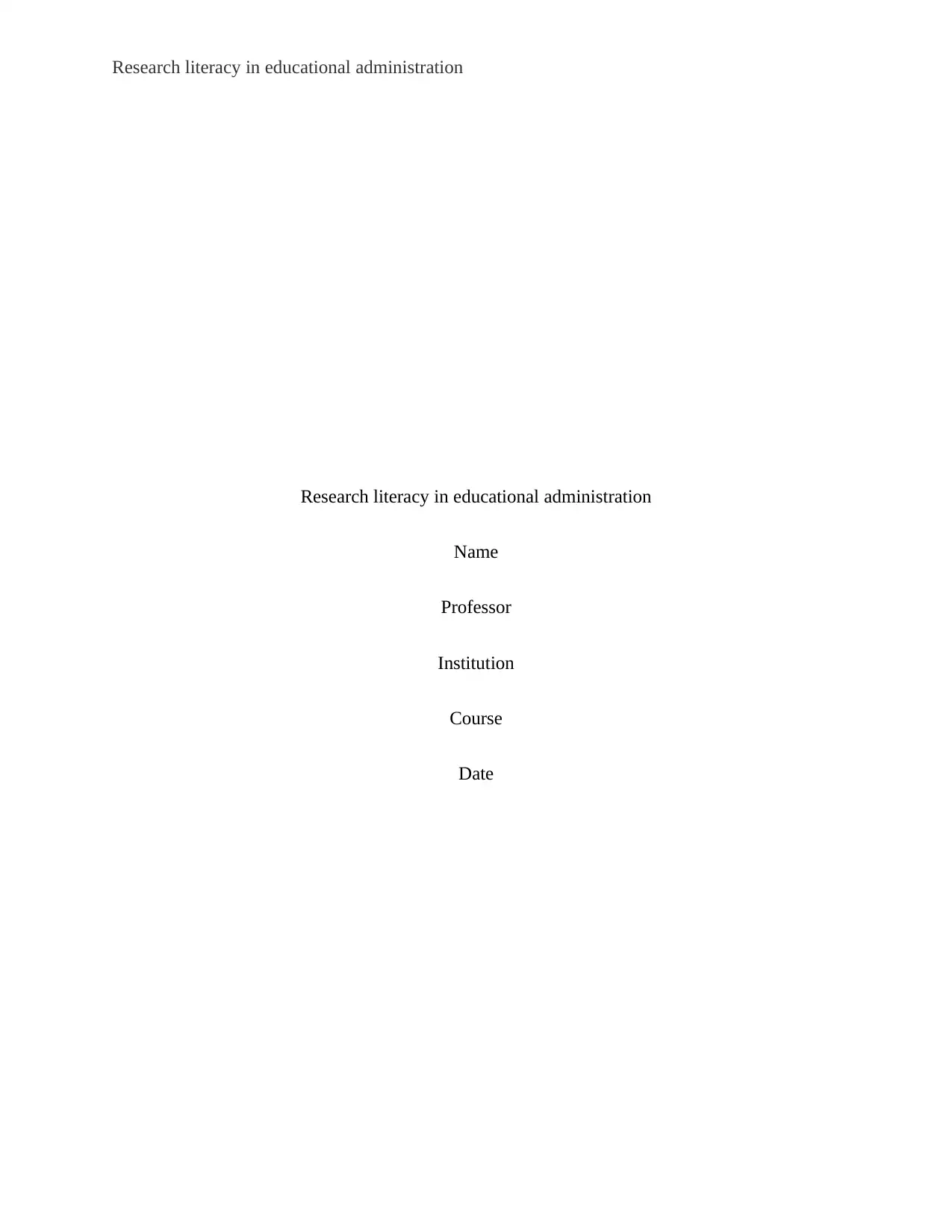
Research literacy in educational administration
Research literacy in educational administration
Name
Professor
Institution
Course
Date
Research literacy in educational administration
Name
Professor
Institution
Course
Date
Paraphrase This Document
Need a fresh take? Get an instant paraphrase of this document with our AI Paraphraser
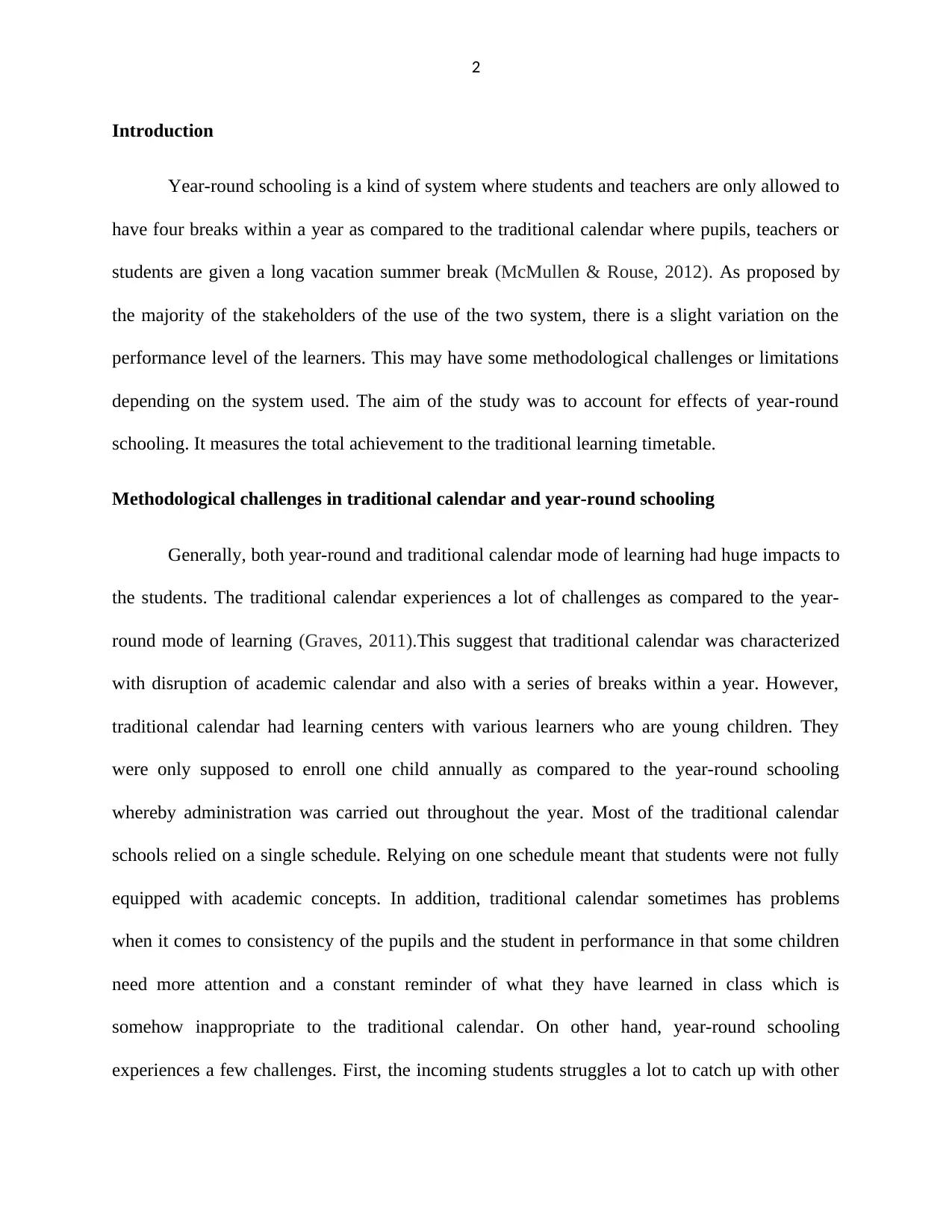
2
Introduction
Year-round schooling is a kind of system where students and teachers are only allowed to
have four breaks within a year as compared to the traditional calendar where pupils, teachers or
students are given a long vacation summer break (McMullen & Rouse, 2012). As proposed by
the majority of the stakeholders of the use of the two system, there is a slight variation on the
performance level of the learners. This may have some methodological challenges or limitations
depending on the system used. The aim of the study was to account for effects of year-round
schooling. It measures the total achievement to the traditional learning timetable.
Methodological challenges in traditional calendar and year-round schooling
Generally, both year-round and traditional calendar mode of learning had huge impacts to
the students. The traditional calendar experiences a lot of challenges as compared to the year-
round mode of learning (Graves, 2011).This suggest that traditional calendar was characterized
with disruption of academic calendar and also with a series of breaks within a year. However,
traditional calendar had learning centers with various learners who are young children. They
were only supposed to enroll one child annually as compared to the year-round schooling
whereby administration was carried out throughout the year. Most of the traditional calendar
schools relied on a single schedule. Relying on one schedule meant that students were not fully
equipped with academic concepts. In addition, traditional calendar sometimes has problems
when it comes to consistency of the pupils and the student in performance in that some children
need more attention and a constant reminder of what they have learned in class which is
somehow inappropriate to the traditional calendar. On other hand, year-round schooling
experiences a few challenges. First, the incoming students struggles a lot to catch up with other
Introduction
Year-round schooling is a kind of system where students and teachers are only allowed to
have four breaks within a year as compared to the traditional calendar where pupils, teachers or
students are given a long vacation summer break (McMullen & Rouse, 2012). As proposed by
the majority of the stakeholders of the use of the two system, there is a slight variation on the
performance level of the learners. This may have some methodological challenges or limitations
depending on the system used. The aim of the study was to account for effects of year-round
schooling. It measures the total achievement to the traditional learning timetable.
Methodological challenges in traditional calendar and year-round schooling
Generally, both year-round and traditional calendar mode of learning had huge impacts to
the students. The traditional calendar experiences a lot of challenges as compared to the year-
round mode of learning (Graves, 2011).This suggest that traditional calendar was characterized
with disruption of academic calendar and also with a series of breaks within a year. However,
traditional calendar had learning centers with various learners who are young children. They
were only supposed to enroll one child annually as compared to the year-round schooling
whereby administration was carried out throughout the year. Most of the traditional calendar
schools relied on a single schedule. Relying on one schedule meant that students were not fully
equipped with academic concepts. In addition, traditional calendar sometimes has problems
when it comes to consistency of the pupils and the student in performance in that some children
need more attention and a constant reminder of what they have learned in class which is
somehow inappropriate to the traditional calendar. On other hand, year-round schooling
experiences a few challenges. First, the incoming students struggles a lot to catch up with other
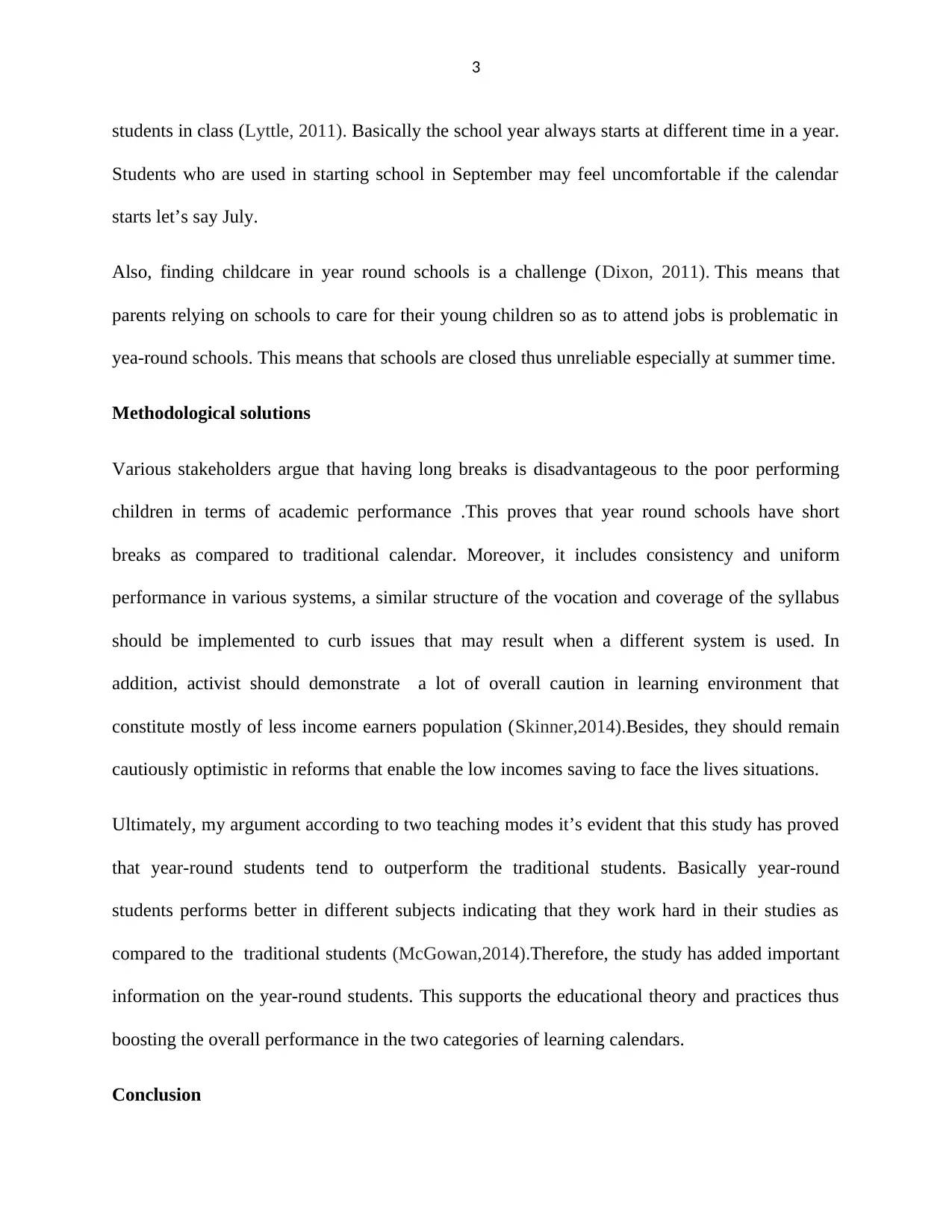
3
students in class (Lyttle, 2011). Basically the school year always starts at different time in a year.
Students who are used in starting school in September may feel uncomfortable if the calendar
starts let’s say July.
Also, finding childcare in year round schools is a challenge (Dixon, 2011). This means that
parents relying on schools to care for their young children so as to attend jobs is problematic in
yea-round schools. This means that schools are closed thus unreliable especially at summer time.
Methodological solutions
Various stakeholders argue that having long breaks is disadvantageous to the poor performing
children in terms of academic performance .This proves that year round schools have short
breaks as compared to traditional calendar. Moreover, it includes consistency and uniform
performance in various systems, a similar structure of the vocation and coverage of the syllabus
should be implemented to curb issues that may result when a different system is used. In
addition, activist should demonstrate a lot of overall caution in learning environment that
constitute mostly of less income earners population (Skinner,2014).Besides, they should remain
cautiously optimistic in reforms that enable the low incomes saving to face the lives situations.
Ultimately, my argument according to two teaching modes it’s evident that this study has proved
that year-round students tend to outperform the traditional students. Basically year-round
students performs better in different subjects indicating that they work hard in their studies as
compared to the traditional students (McGowan,2014).Therefore, the study has added important
information on the year-round students. This supports the educational theory and practices thus
boosting the overall performance in the two categories of learning calendars.
Conclusion
students in class (Lyttle, 2011). Basically the school year always starts at different time in a year.
Students who are used in starting school in September may feel uncomfortable if the calendar
starts let’s say July.
Also, finding childcare in year round schools is a challenge (Dixon, 2011). This means that
parents relying on schools to care for their young children so as to attend jobs is problematic in
yea-round schools. This means that schools are closed thus unreliable especially at summer time.
Methodological solutions
Various stakeholders argue that having long breaks is disadvantageous to the poor performing
children in terms of academic performance .This proves that year round schools have short
breaks as compared to traditional calendar. Moreover, it includes consistency and uniform
performance in various systems, a similar structure of the vocation and coverage of the syllabus
should be implemented to curb issues that may result when a different system is used. In
addition, activist should demonstrate a lot of overall caution in learning environment that
constitute mostly of less income earners population (Skinner,2014).Besides, they should remain
cautiously optimistic in reforms that enable the low incomes saving to face the lives situations.
Ultimately, my argument according to two teaching modes it’s evident that this study has proved
that year-round students tend to outperform the traditional students. Basically year-round
students performs better in different subjects indicating that they work hard in their studies as
compared to the traditional students (McGowan,2014).Therefore, the study has added important
information on the year-round students. This supports the educational theory and practices thus
boosting the overall performance in the two categories of learning calendars.
Conclusion
⊘ This is a preview!⊘
Do you want full access?
Subscribe today to unlock all pages.

Trusted by 1+ million students worldwide
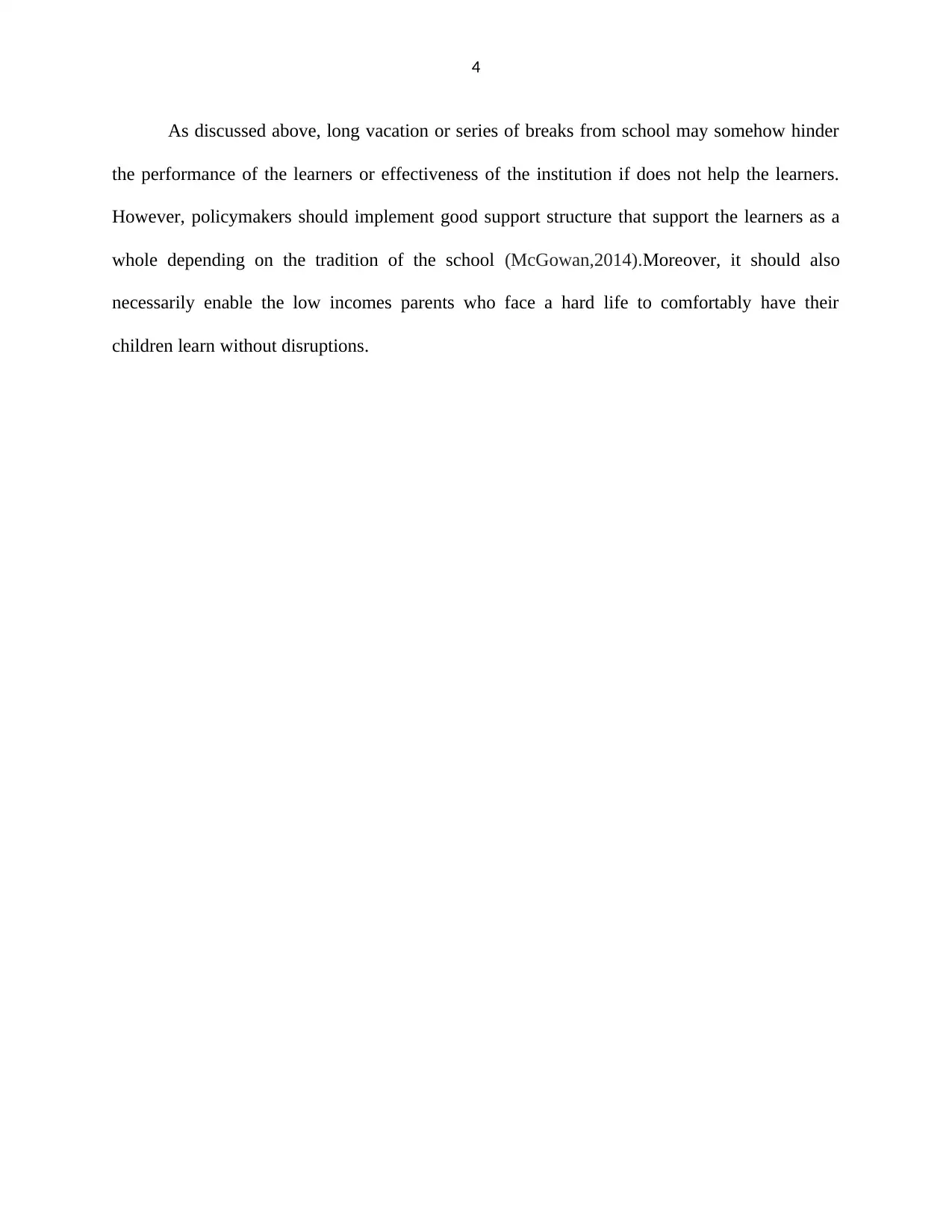
4
As discussed above, long vacation or series of breaks from school may somehow hinder
the performance of the learners or effectiveness of the institution if does not help the learners.
However, policymakers should implement good support structure that support the learners as a
whole depending on the tradition of the school (McGowan,2014).Moreover, it should also
necessarily enable the low incomes parents who face a hard life to comfortably have their
children learn without disruptions.
As discussed above, long vacation or series of breaks from school may somehow hinder
the performance of the learners or effectiveness of the institution if does not help the learners.
However, policymakers should implement good support structure that support the learners as a
whole depending on the tradition of the school (McGowan,2014).Moreover, it should also
necessarily enable the low incomes parents who face a hard life to comfortably have their
children learn without disruptions.
Paraphrase This Document
Need a fresh take? Get an instant paraphrase of this document with our AI Paraphraser
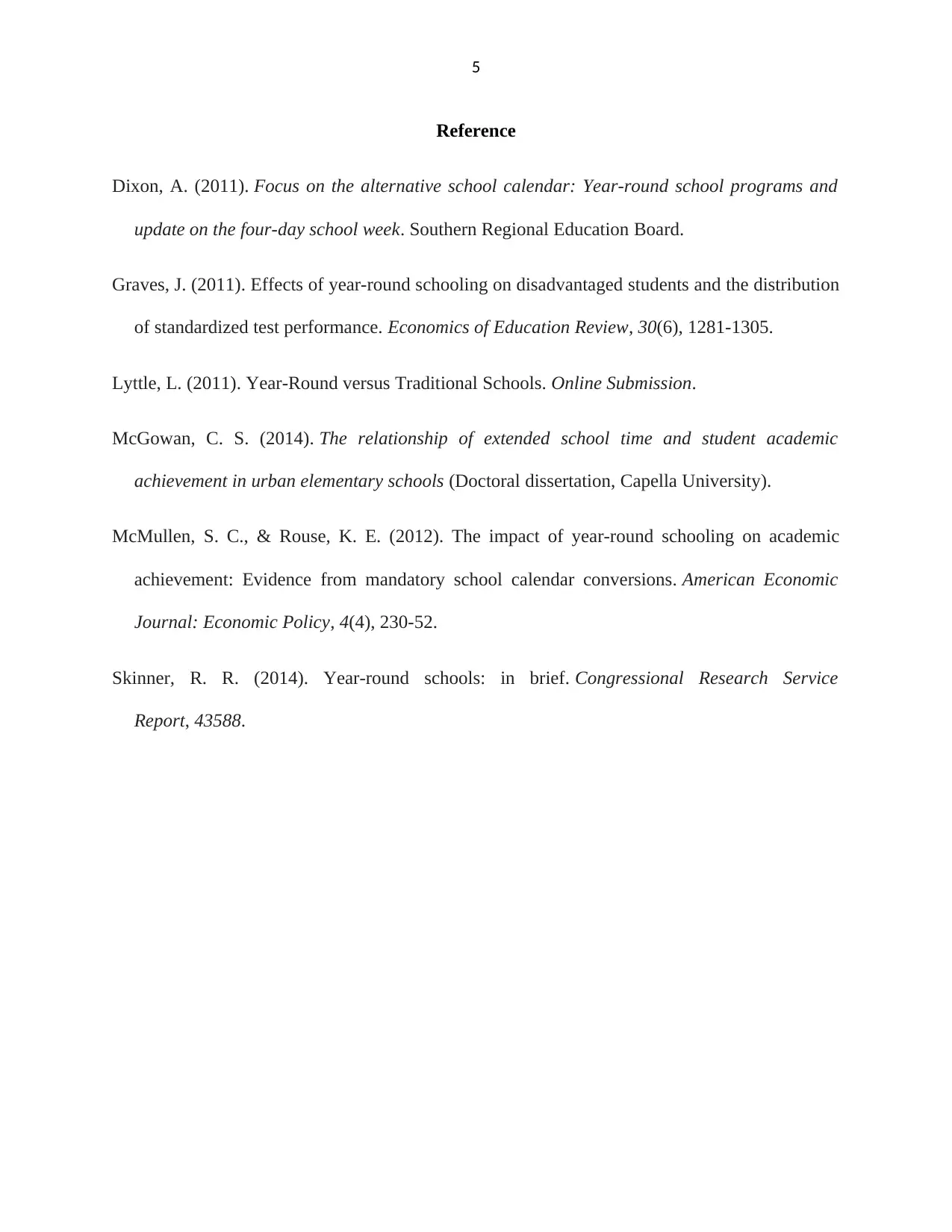
5
Reference
Dixon, A. (2011). Focus on the alternative school calendar: Year-round school programs and
update on the four-day school week. Southern Regional Education Board.
Graves, J. (2011). Effects of year-round schooling on disadvantaged students and the distribution
of standardized test performance. Economics of Education Review, 30(6), 1281-1305.
Lyttle, L. (2011). Year-Round versus Traditional Schools. Online Submission.
McGowan, C. S. (2014). The relationship of extended school time and student academic
achievement in urban elementary schools (Doctoral dissertation, Capella University).
McMullen, S. C., & Rouse, K. E. (2012). The impact of year-round schooling on academic
achievement: Evidence from mandatory school calendar conversions. American Economic
Journal: Economic Policy, 4(4), 230-52.
Skinner, R. R. (2014). Year-round schools: in brief. Congressional Research Service
Report, 43588.
Reference
Dixon, A. (2011). Focus on the alternative school calendar: Year-round school programs and
update on the four-day school week. Southern Regional Education Board.
Graves, J. (2011). Effects of year-round schooling on disadvantaged students and the distribution
of standardized test performance. Economics of Education Review, 30(6), 1281-1305.
Lyttle, L. (2011). Year-Round versus Traditional Schools. Online Submission.
McGowan, C. S. (2014). The relationship of extended school time and student academic
achievement in urban elementary schools (Doctoral dissertation, Capella University).
McMullen, S. C., & Rouse, K. E. (2012). The impact of year-round schooling on academic
achievement: Evidence from mandatory school calendar conversions. American Economic
Journal: Economic Policy, 4(4), 230-52.
Skinner, R. R. (2014). Year-round schools: in brief. Congressional Research Service
Report, 43588.
1 out of 5
Related Documents
Your All-in-One AI-Powered Toolkit for Academic Success.
+13062052269
info@desklib.com
Available 24*7 on WhatsApp / Email
![[object Object]](/_next/static/media/star-bottom.7253800d.svg)
Unlock your academic potential
Copyright © 2020–2025 A2Z Services. All Rights Reserved. Developed and managed by ZUCOL.





